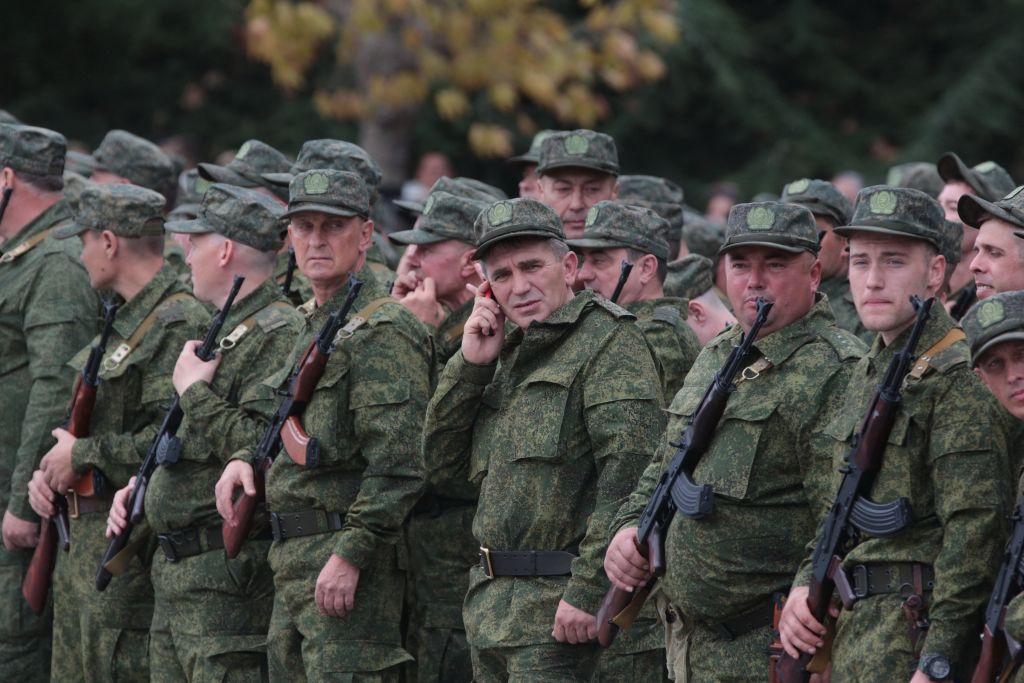Russia’s ‘Holy Land’ is looking more and more vulnerable

Reservists drafted during the partial mobilisation attend a departure ceremony in Sevastopol, Crimea, on September 27, 2022. (Photo by STRINGER/AFP via Getty Images)
SUMMARY
From 2014 to 2021, Russian President Vladimir Putin made a series of odd claims declaring that Crimea is everything to Russia, from its "Temple Mount" to "...a holy land for us, for Russians." Russian historians were not so sure about the comparison.
But the bridges between Russia and Crimea are crumbling. The Black Sea Fleet is under regular attack. Russian air defenses are dying to the exact weapons they're supposed to shield against. And Ukrainians are pressuring the last of the vaunted Russian land bridge supply routes. "Temple Mount" looks quite vulnerable.
The pressure on Sevastopol and the Black Sea Fleet
The Black Sea Fleet boasts a long history and an important place in the Russian navy strategy and structure. But Russia's expansion of the war in Ukraine in 2022 forced Ukraine to get creative. Ukraine received Western arms and found new ways to attack enemy vessels.
Ukraine started by firing small missiles from their coast against Russian vessels that came close, as well as audacious attacks like the air-to-surface destruction of the Muskva. But over time, it developed its own surface and undersea drones and other weapons to attack Russian ships in port.
In just the last week, Ukraine reportedly attacked at least three Russian patrol ships in addition to the much-discussed destruction of a submarine and an amphibious landing ship.
According to U.S. Navy Retired Rear Adm. Mark Montgomery, "If you’re on a Russian naval ship, you’re not safe anywhere in the Black Sea, but you’re particularly not safe in a fixed location—in port or at anchor."
And those ships are needed to protect the already vulnerable supply lines and bridges going into the Crimean Peninsula. Their failure makes the peninsula more open to attack.
Meanwhile, Crimean supply is already dicey
While Crimea has great static defenses emplaced over nearly a decade, its defenders need to eat, their trucks need fuel, and their weapons need ammo. But Ukraine is severely restricting the supply lines into Crimea, to the point that Russia likely needs to evacuate the remaining civilians and beachgoers while rushing as much winter supply in as possible.
It is not doing so yet.
Supply into Crimea and the areas west of it comes primarily through actual bridges connected to Russia or through the "land bridge," occupied Ukrainian territory stretching from Russia to the Black Sea.
But Ukraine struck Russian bridges repeatedly, cutting the number of vehicles and amount of weight that can cross the bridge at any time. Additional attacks against the supports or road surface would choke Russia even more. And a strong hit against the rail bridge would put an end to effective levels of resupply.
Meanwhile, Ukraine has technically reached a point where it can close the land bridge using HIMARs, though it doing so is unlikely unless it can take a bit more territory.
With additional pressure on both or a successful severing of one or the other, Russian supply going into the winter would fail.
Russia appears to understand the stakes. While it has famously conserved its quite large air force after heavy losses early in the war, jets now strike Ukraine's deepest penetrations. Russia needs to stop all progress in that salient, and it knows it. Committing air forces might slow Ukrainian progress, but only by risking Russia's already poorly performing pilots.
And Russian air defenses are dying to air attacks
One of the main defenses for Crimea is the network of surface-to-air missiles supposed to keep the Ukrainian air forces at bay.
But Ukraine hit another S-400 "Triumf" missile system on September 14, the day after it hit the two major ships of the Black Sea Fleet. That's the second battery blown up in the last month, pointing to a systemic failure of the units to defend against aerial attacks, which is literally their exact job.
So Crimean forces suffer regular hits from the air and sea as the land offensive slowly chokes it of needed supply headed into winter. Russia still has more combat mass than Ukraine, but the bear needs to get some serious fat on its bones if it's going to survive the cold months ahead.
SHARE
